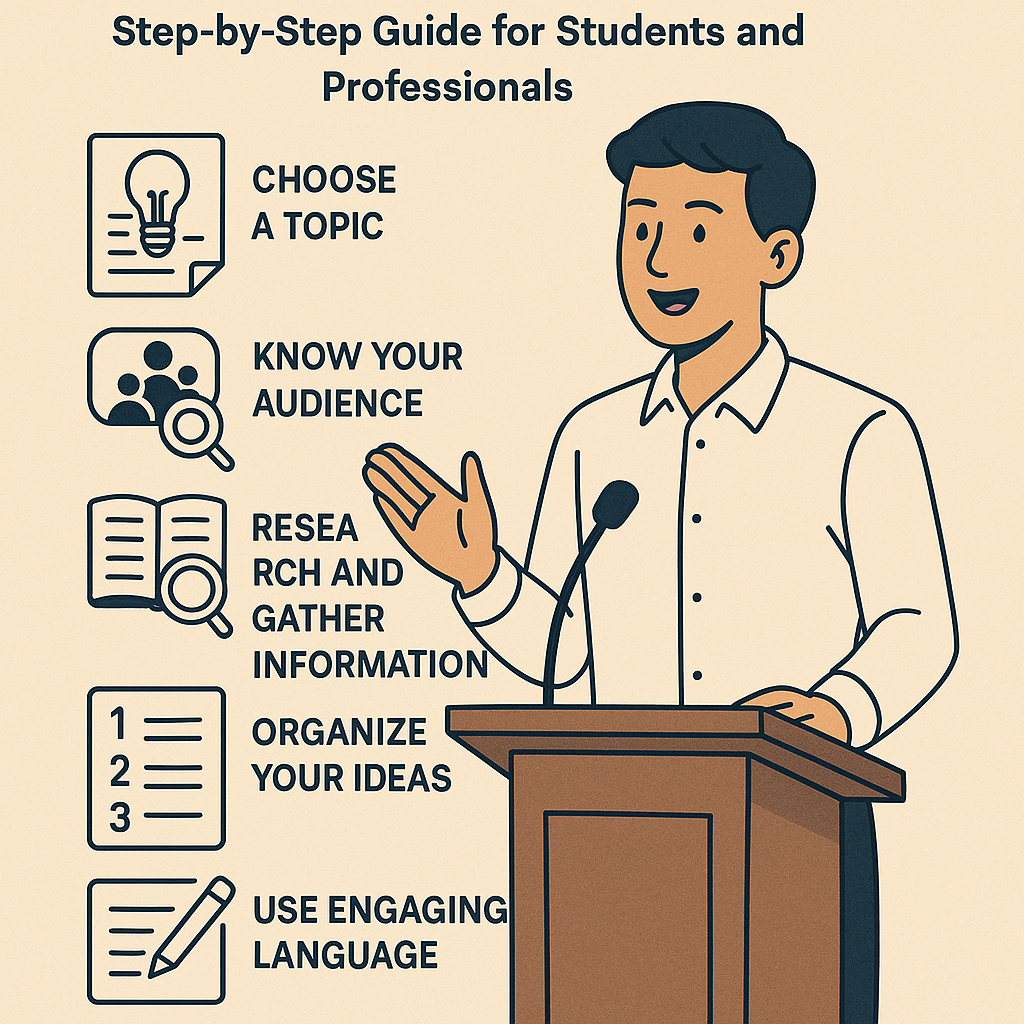
How to Write a Memorable Speech: Step-by-Step Guide for Students and Professionals
October 20, 2025
Writing a memorable speech is more than arranging words—it’s about crafting a message that resonates, inspires, and stays in the audience’s minds long after you leave the stage. Whether you’re a student preparing for a school presentation or a professional delivering a keynote, knowing how to structure and express your ideas effectively can transform your delivery from ordinary to unforgettable. If you want to make your message shine with expert precision, using a trusted speech writing service like Write Essay Today can help you organize your thoughts and deliver them with impact.
In this guide, we’ll walk you step-by-step through the process of writing a powerful, memorable speech that captivates any audience—from planning your message to perfecting your delivery.
Step 1: Understand the Purpose of Your Speech
Every great speech begins with a clear purpose. Are you trying to inform, persuade, motivate, or inspire your listeners? Defining your purpose early ensures your words stay focused and meaningful. For example:
- An informative speech aims to teach something new.
- A persuasive speech seeks to change opinions or behaviors.
- A motivational speech inspires action or belief.
When you know why you’re speaking, you can tailor your tone, content, and examples to achieve that goal effectively.
Step 2: Know Your Audience
Your speech’s impact depends heavily on understanding who’s listening. A speech that connects with college students may sound very different from one meant for corporate executives. Research your audience’s background, interests, and expectations.
Ask yourself:
- What challenges or goals does my audience have?
- What tone would resonate best—formal, casual, or motivational?
- What level of knowledge do they have on this topic?
By tailoring your message to your audience’s mindset, you make it easier for them to engage and remember your speech.
Step 3: Choose a Strong and Relevant Topic
A memorable speech begins with a topic that matters—to you and your listeners. Pick something that aligns with your passion and your audience’s needs. If you’re emotionally invested in your topic, your energy and enthusiasm will naturally shine through.
Here’s a quick tip: if you’re unsure where to start, think about a topic that answers a question, solves a problem, or challenges a common belief. Relevance is what turns an ordinary speech into an inspiring one.
Step 4: Craft a Clear Central Message
Your central message—or thesis—is the heartbeat of your speech. It should summarize your main idea in one concise sentence. For example:
- “Small acts of kindness can change entire communities.”
- “Success is built not on luck, but on consistent effort.”
Once you’ve defined your message, every part of your speech should reinforce it. Keep your message focused—one speech, one key idea. Audiences remember clarity, not complexity.
Step 5: Create an Engaging Outline
Before writing your full speech, sketch a clear outline. This helps you organize ideas logically and maintain a smooth flow. A simple but effective speech structure includes:
- Introduction – Grab attention and state your main point.
- Body – Present 2–3 key points that support your message.
- Conclusion – Summarize and leave your audience with something to remember.
Outlining prevents rambling and ensures that your speech transitions naturally from one point to the next.
Step 6: Write a Powerful Opening
Your introduction sets the tone. Begin with something that grabs attention instantly—a question, a surprising fact, a relatable story, or a thought-provoking quote. For example:
“Every minute, over 200 million emails are sent. But how many of them truly make a connection?”
The first few lines should spark curiosity and clearly state why your topic matters. A great opening promises value and sets the emotional foundation for what’s to come.
Step 7: Support Your Points with Evidence and Stories
Once your audience is hooked, it’s time to build trust and depth. Use a mix of facts, statistics, examples, and personal anecdotes to back up your main points.
- Facts add credibility.
- Stories add relatability.
- Examples make abstract ideas concrete.
For instance, if your topic is about teamwork, share a personal experience of how collaboration led to success. Stories make your message human, emotional, and unforgettable.
Step 8: Use Transitions for Flow
Smooth transitions help your audience follow your message easily. Simple phrases like “Now let’s look at…” or “Building on that idea…” guide listeners naturally through your points. Avoid abrupt jumps that confuse the audience—cohesion makes your speech feel professional and well-thought-out.
Step 9: Write a Strong and Memorable Conclusion
Your conclusion is your final opportunity to leave an impression. It should:
- Reinforce your main message.
- Inspire your audience to act or reflect.
- End with a powerful line they won’t forget.
Try ending with a call to action, a moving quote, or a summary that ties back to your opening. For example:
“If each of us took one small step today toward change, imagine how far we could go tomorrow.”
A memorable closing creates emotional resonance and encourages your audience to think long after you’ve finished speaking.
Step 10: Edit for Clarity and Impact
Once your draft is complete, refine it for clarity, tone, and length. Great speeches are clear, concise, and conversational. Cut unnecessary words, simplify complex ideas, and focus on rhythm. Reading aloud is the best way to test flow and identify awkward phrasing.
Editing isn’t just about grammar—it’s about ensuring every sentence serves a purpose. A concise speech keeps your audience’s attention and makes your delivery more confident.
Step 11: Practice Delivery and Body Language
A well-written speech can fall flat without effective delivery. Practice in front of a mirror or record yourself to observe your pacing, tone, and gestures. Remember to:
- Maintain eye contact.
- Use hand movements naturally.
- Vary your voice tone to emphasize key points.
- Pause strategically for effect.
Confidence grows with repetition. The more familiar you are with your speech, the more naturally you’ll connect with your audience.
Step 12: Engage the Audience
Interaction turns a good speech into an unforgettable one. Ask rhetorical questions, invite reflection, or encourage brief participation. A simple question like “Can you recall a time when you faced this challenge?” draws people into your message. Engagement creates connection—and connection creates memory.
Step 13: Use Visual Aids Wisely
Slides, props, or short videos can strengthen your speech, but only when used purposefully. Visuals should enhance your message, not distract from it. Keep them simple, relevant, and easy to understand at a glance.
If you use slides, avoid filling them with text. Instead, use images, keywords, or statistics that reinforce what you’re saying. Remember—the audience came to hear you, not read your slides.
Step 14: Manage Speech Anxiety
Even experienced speakers feel nervous. The key is learning to channel that energy positively. Here’s how:
- Prepare thoroughly—confidence comes from readiness.
- Breathe deeply before starting.
- Focus on your message, not on yourself.
- Visualize success—imagine delivering your speech confidently and being applauded for it.
Remind yourself that the audience is on your side. They want you to succeed, not fail. With practice, nervousness becomes excitement.
Step 15: Seek Feedback and Keep Improving
After delivering your speech, ask for feedback from peers, mentors, or instructors. Constructive criticism helps you identify strengths and areas for improvement. Over time, you’ll refine your speaking style, pacing, and content creation skills.
Speech writing and delivery are lifelong learning processes—each experience teaches you something new about how to connect, inspire, and communicate effectively.
Why Writing a Great Speech Matters
Whether you’re presenting an academic topic, pitching a business idea, or delivering a graduation address, your ability to write and present a memorable speech reflects your communication, leadership, and emotional intelligence. Great speeches have the power to move people, influence decisions, and shape perspectives.
If crafting your message feels overwhelming, you can always turn to professionals who understand the nuances of speech writing. Expert writers at Write Essay Today specialize in helping students and professionals create customized speeches that sound authentic, persuasive, and impactful.
Wrapping Up
Writing a memorable speech isn’t just about good vocabulary or perfect grammar—it’s about connection, structure, and authenticity. Start with a clear purpose, understand your audience, and craft a message that feels both logical and heartfelt. Blend facts with emotion, and practice until your delivery feels natural.
When written and delivered with intention, your speech can educate, motivate, and inspire. Whether you’re preparing for a classroom presentation or a high-stakes professional event, remember: the right words can change how people think—and even how they act.
And if you ever need expert assistance turning your ideas into powerful words, Write Essay Today is always ready to help you craft speeches that truly leave a mark.







